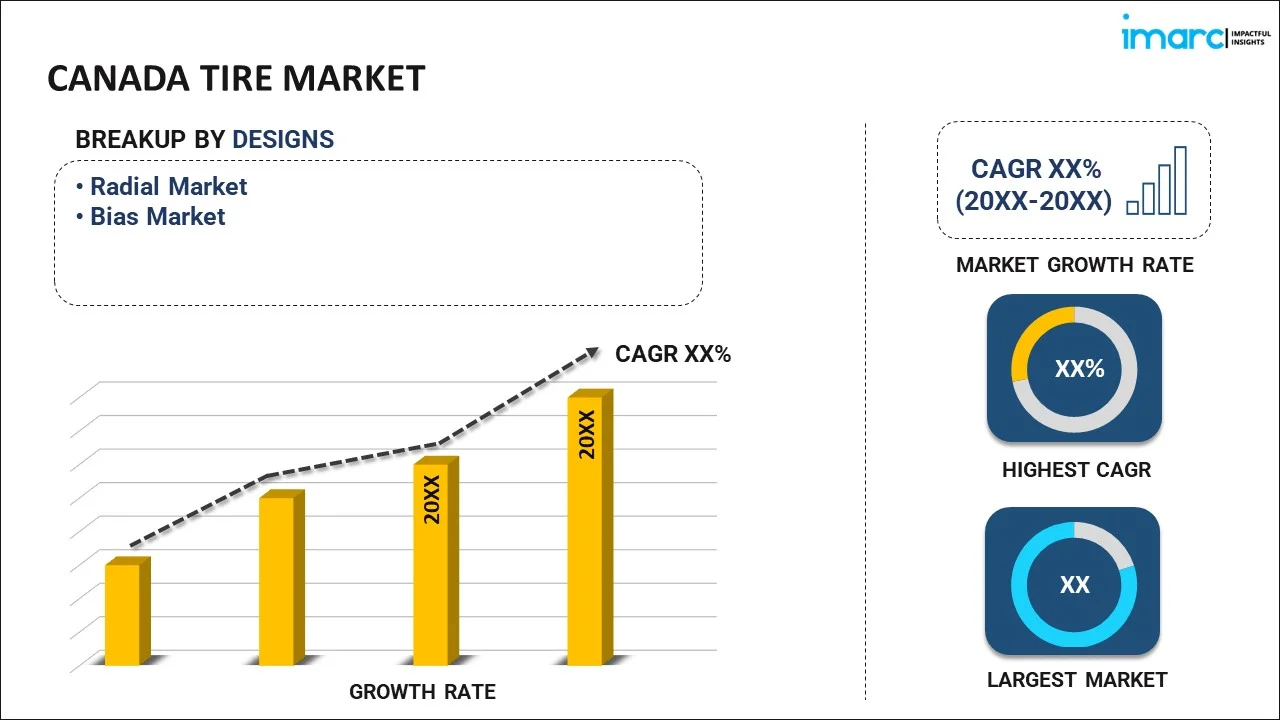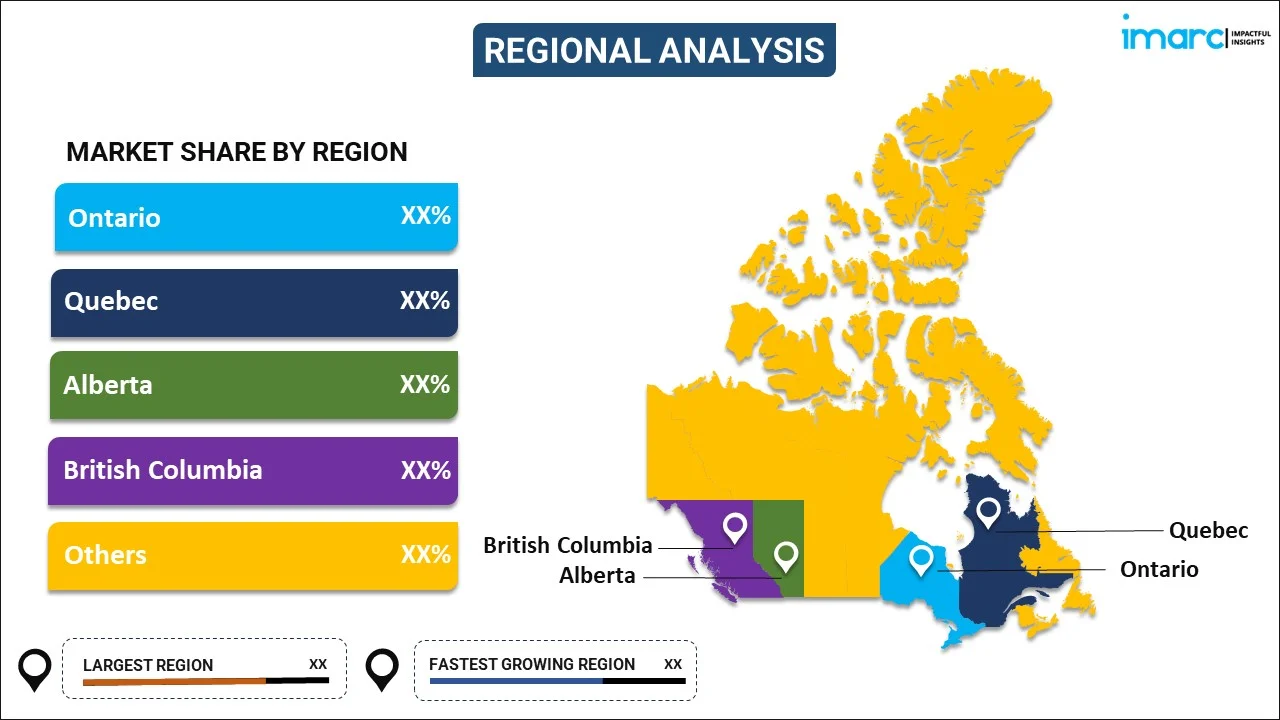
Canada Tire Market Report by Design (Radial Market, Bias Market), End-Use (OEM Market, Replacement Market), Vehicle Type (Passenger Cars, Light Commercial Vehicles, Medium and Heavy Commercial Vehicles, Two Wheelers, Three Wheelers, Off-The-Road (OTR)), Distribution Channel (Offline, Online), Season (All Season Tires, Winter Tires, Summer Tires), and Region 2025-2033
Canada Tire Market Overview:
The Canada tire market size reached USD 3,478.4 Million in 2024. Looking forward, IMARC Group expects the market to reach USD 5,028.5 Million by 2033, exhibiting a growth rate (CAGR) of 4.18% during 2025-2033.. The market is growing rapidly, driven by rising vehicle production and sales in the country, increasing aftermarket demand in Canada, and recent technological advancements like the development of fuel-efficient tires, run-flat tires, and tires with advanced tread designs and materials thus aiding the Canada tire market share.
|
Report Attribute
|
Key Statistics
|
|---|---|
|
Base Year
|
2024
|
|
Forecast Years
|
2025-2033
|
|
Historical Years
|
2019-2024
|
|
Market Size in 2024
|
USD 3,478.4 Million |
|
Market Forecast in 2033
|
USD 5,028.5 Million |
| Market Growth Rate 2025-2033 | 4.18% |
Canada Tire Market Analysis:
- Major Drivers: Increasing vehicle ownership, harsh winter conditions necessitating seasonal tires, technological advancements in tire design, and rising demand for fuel-efficient and electric vehicles drive consistent market growth.
- Key Market Trends: Some of the key Canada tire market trends are the sustainable and eco-friendly tires, rise in online tire sales, integration of smart tire technologies, and increased consumer preference for all-weather tires over seasonal swaps are reshaping Canada's tire market.
- Market Opportunities: Expanding EV market demands specialized tires, rural and remote area penetration, retreading and recycling innovations, and enhanced e-commerce logistics provide lucrative growth opportunities for tire manufacturers and retailers in Canada.
- Market Challenges: Stringent environmental regulations, high raw material costs, supply chain disruptions, and seasonal demand fluctuations pose significant challenges to consistent profitability and operations in Canada tire market analysis.
Canada Tire Market Trends:
Rising Vehicle Production and Sales
Canada's automotive industry is well-established, with major global manufacturers. Vehicle production is stable in the country, ensuring a constant demand for original equipment tires (OET) used in new vehicles. Furthermore, the improving economy and convenient financing choices have made vehicle ownership more accessible to a greater segment of the population, which is fueling the Canada tire market growth. Also, the proliferation of electric vehicles (EVs) and advancements in automotive technology have spurred demand for specialized tires designed to enhance the performance and efficiency of EVs. As the number of vehicles on Canadian roads continues to climb, the need for high-quality, durable, and performance-oriented tires rises correspondingly.
Growing Aftermarket Demand
The aftermarket demand for tires in Canada is a significant growth driver. As vehicles age, their tires wear out, necessitating replacements to maintain safety and performance. This creates a steady stream of demand in the aftermarket segment. Additionally, the Canadian climate, characterized by its harsh winters and varied terrain, exacerbates tire wear, further boosting the need for frequent tire replacements. Besides this, consumers in Canada are becoming more knowledgeable about the importance of tire maintenance and the benefits of using high-quality, season-appropriate tires, which drives demand in the aftermarket. Furthermore, the rise in the average vehicle lifespan, which leads to more vehicles on the road for longer periods, requiring multiple tire replacements over their lifecycle, is strengthening the Canada tire market demand.
Technological Advancements
Innovations such as the development of fuel-efficient tires, run-flat tires, and tires with advanced tread designs and materials have greatly enhanced tire performance, safety, and durability. Fuel-efficient tires, for example, are designed to reduce rolling resistance, thereby improving a vehicle's fuel economy and reducing carbon emissions. This aligns with the growing consumer and regulatory focus on sustainability and environmental impact. Additionally, run-flat tires provide enhanced safety by allowing vehicles to continue driving for a limited distance after a puncture, reducing the risk of accidents and the inconvenience of immediate tire changes. Besides this, advanced tread designs and the use of new materials improve traction, handling, and longevity, making tires more reliable and cost-effective over their lifespan. These technological advancements not only attract consumers looking for better performance and value but also drive up the average selling price of tires, boosting market revenue. Moreover, the ongoing research and development (R&D) in tire technology, which ensures a continuous pipeline of innovative products, is positively impacting the market growth.
Canada Tire Market Segmentation:
IMARC Group provides an analysis of the key trends in each segment of the market, along with forecasts at the country level for 2025-2033. Our report has categorized the market based on design, end-use, vehicle type, distribution channel, and season.
Design Insights:

To get more information on this market, Request Sample
- Radial Market
- Bias Market
The report has provided a detailed breakup and analysis of the market based on the design. This includes radial market and bias market.
End-Use Insights:
- OEM Market
- Replacement Market
A detailed breakup and analysis of the market based on the end-use have also been provided in the report. This includes OEM market and replacement market.
Vehicle Type Insights:
- Passenger Cars
- Light Commercial Vehicles
- Medium and Heavy Commercial Vehicles
- Two Wheelers
- Three Wheelers
- Off-The-Road (OTR)
The report has provided a detailed breakup and analysis of the market based on the vehicle type. This includes passenger cars, light commercial vehicles, medium and heavy commercial vehicles, two wheelers, three wheelers, and off-the-road (OTR).
Distribution Channel Insights:
- Offline
- Online
A detailed breakup and analysis of the market based on the distribution channel have also been provided in the report. This includes offline and online.
Season Insights:
- All Season Tires
- Winter Tires
- Summer Tires
The report has provided a detailed breakup and analysis of the market based on the season. This includes all season tires, winter tires, and summer tires.
Regional Insights:

- Ontario
- Quebec
- Alberta
- British Columbia
- Others
The report has also provided a comprehensive analysis of all the major regional markets, which include Ontario, Quebec, Alberta, British Columbia, and Others.
Competitive Landscape:
The market research report has also provided a comprehensive analysis of the competitive landscape. Competitive analysis such as market structure, key player positioning, top winning strategies, competitive dashboard, and company evaluation quadrant has been covered in the report. Also, detailed profiles of all major companies have been provided.
Latest News and Developments:
- In August 2025, Toronto-based TireSet.ca launched across Canada, offering Buy Now, Pay Later tire financing with credit approvals starting at 550 and no hard credit checks. The online retailer provides a wide range of passenger, light truck, and commercial tires, plus custom wheels. With flexible iFinance Canada payment plans and free nationwide shipping, TireSet.ca aims to make tire purchases easier and more accessible for Canadian drivers.
- In May 2025, Canadian Tire Corporation and WestJet formed a strategic partnership, launching in early 2026, to link Triangle Rewards and WestJet Rewards programs. Members can earn both Canadian Tire Money and WestJet points on flights, vacations, and retail purchases. The partnership offers exclusive promotions, enhanced earn rates with co-branded Mastercards, and the ability to convert points, deepening customer loyalty and expanding value across travel and everyday shopping.
Canada Tire Market Report Coverage:
| Report Features | Details |
|---|---|
| Base Year of the Analysis | 2024 |
| Historical Period | 2019-2024 |
| Forecast Period | 2025-2033 |
| Units | Million USD |
| Scope of the Report | Exploration of Historical Trends and Market Outlook, Industry Catalysts and Challenges, Segment-Wise Historical and Future Market Assessment:
|
| Designs Covered | Radial Market, Bias Market |
| End-Uses Covered | OEM Market, Replacement Market |
| Vehicle Types Covered | Passenger Cars, Light Commercial Vehicles, Medium and Heavy Commercial Vehicles, Two Wheelers, Three Wheelers, Off-The-Road (OTR) |
| Distribution Channels Covered | Offline, Online |
| Seasons Covered | All Season Tires, Winter Tires, Summer Tires |
| Regions Covered | Ontario, Quebec, Alberta, British Columbia, Others |
| Customization Scope | 10% Free Customization |
| Post-Sale Analyst Support | 10-12 Weeks |
| Delivery Format | PDF and Excel through Email (We can also provide the editable version of the report in PPT/Word format on special request) |
Key Benefits for Stakeholders:
- IMARC’s industry report offers a comprehensive quantitative analysis of various market segments, historical and current market trends, market forecasts, and dynamics of the Canada tire market from 2019-2033.
- The research report provides the latest information on the market drivers, challenges, and opportunities in the Canada tire market.
- Porter's five forces analysis assist stakeholders in assessing the impact of new entrants, competitive rivalry, supplier power, buyer power, and the threat of substitution. It helps stakeholders to analyze the level of competition within the Canada tire industry and its attractiveness.
- Competitive landscape allows stakeholders to understand their competitive environment and provides an insight into the current positions of key players in the market.
Key Questions Answered in This Report
The tire market in Canada was valued at USD 3,478.4 Million in 2024.
The Canada tire market is projected to exhibit a CAGR of 4.18% during 2025-2033, reaching a value of USD 5,028.5 Million by 2033.
Key factors driving the Canada tire market include harsh winter conditions requiring seasonal tires, increasing vehicle ownership, growth in electric and hybrid vehicles, rising demand for fuel-efficient tires, and advancements in tire technology. Additionally, expanding e-commerce and flexible financing options are enhancing tire accessibility and boosting consumer demand nationwide.
Need more help?
- Speak to our experienced analysts for insights on the current market scenarios.
- Include additional segments and countries to customize the report as per your requirement.
- Gain an unparalleled competitive advantage in your domain by understanding how to utilize the report and positively impacting your operations and revenue.
- For further assistance, please connect with our analysts.
 Request Customization
Request Customization
 Speak to an Analyst
Speak to an Analyst
 Request Brochure
Request Brochure
 Inquire Before Buying
Inquire Before Buying




.webp)




.webp)












